High Reliability:
High reliability refers to the perfection and excellence in a device or it can be used for the long term without any fault. In this article, a High-reliability driver is a driver that is protected from the damages like overcurrent, short circuits, high currents, and overheating and can be used in large-scale applications like avionics.
Phase Shift in Avionics:
Avionics refers to the electronic systems designed for use in aviation. It is a combination of both aircraft and electronic systems. It includes navigation, flight control, engine control system, fault or damage detection, and communication. Applications of avionics are in Commercial airliners, helicopters, military fighter jets, and spacecraft. They use avionics to provide services, track and identify performance measures, and operate within established safety parameters.
In avionics, communication through RADAR is very crucial. The TLC6A598 is responsible for communication and safety in avionics. They control the phase of elements in a phased array antenna in communication, especially in RADAR. This is how communication is possible in avionics.
Introduction to TLC6A598:
The TLC6A598 device is a monolithic, high-voltage, high-current power 8-bit shift register designed for use in systems that require relatively high load power, such as LEDs. This device has built-in voltage clamps on the output side for inductive transient protection, so it can also drive relays, solenoids, and other low-current or high-voltage loads. They can limit the current level to avoid any short circuits in the device. This device is highly reliable and robust for avionic applications.
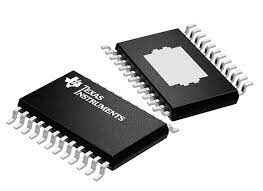
It contains an 8-bit serial-in, parallel-out shift register that is used to provide an 8-bit D-type storage register. Outputs are low-side, open-drain DMOS transistors with output ratings of 50 V and 350-mA continuous sink-current capabilities. The current limit decreases as the junction temperature increases for additional device protection. A built-in load open or load short diagnostic mechanism provides enhanced safety protection. The device provides a cycle redundancy check to verify register values in the shift registers. This chip has a range of operating voltage i.e. -55◦C to 125◦C.
Board Design:
I have designed a board using a TLC6A598 device. The purpose of designing this board is to provide an example of the solution of controlling 8 channel relays. This board helps users evaluate the operation and performance of the TLC6A598. It operates with two power supplies i.e. 5V DC and 24V DC. One of them is used to control TLC6A598 and the other one is used to provide power to relays.
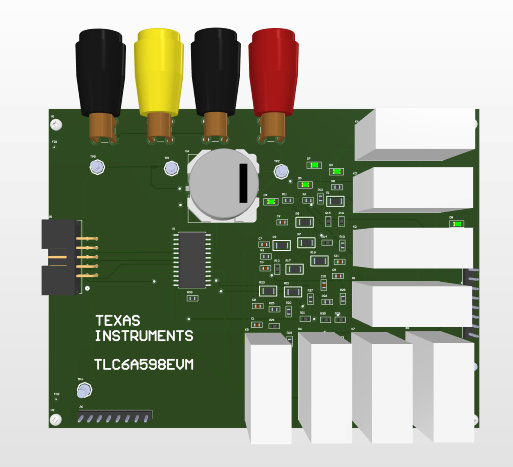
Design files:
I have uploaded the schematic file of this board online on Inventhub. The viewers can visually view and download it to implement my design.

For a better view of my PCB design board in different layers, I have uploaded the PCB file of my design on Inventhub. The manufacturer can easily download this file and implement my design on a board without any error.
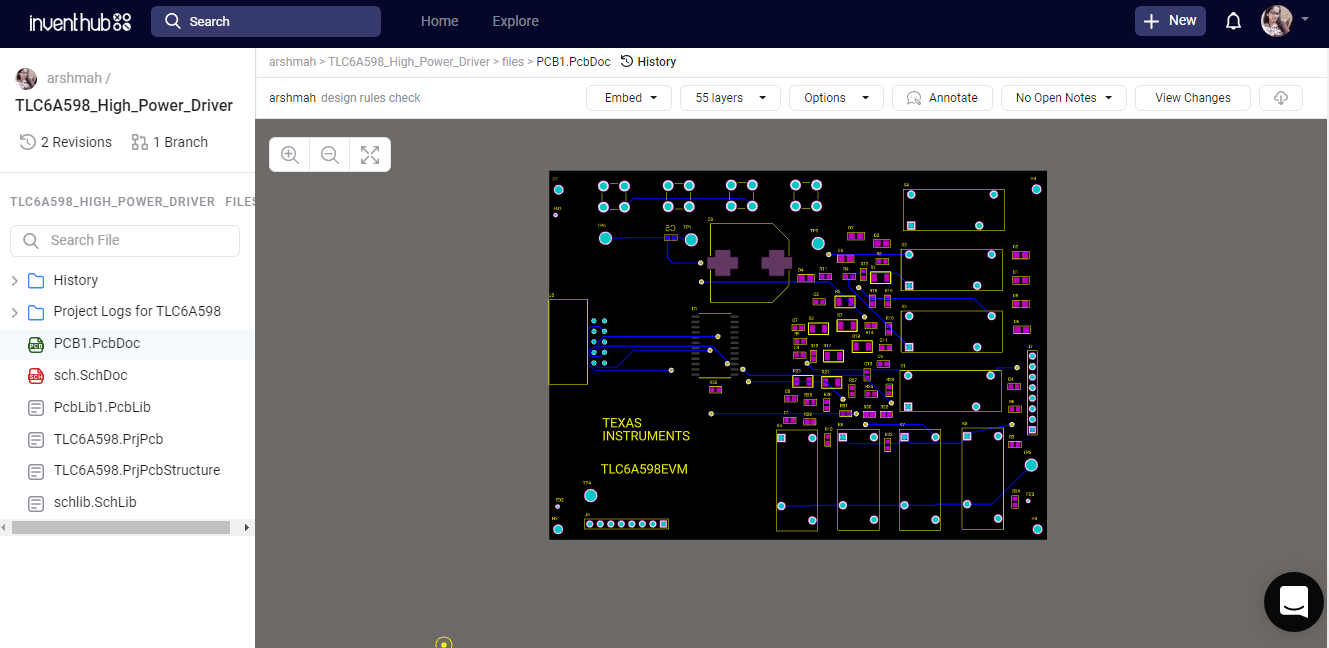
For fabrication of this board, I have created a release file of the project which is a ZIP file containing all schematic, PCB, routing layers, and 3D model of the chip. To fabricate my PCB, I will send this release file to my manufacturer instead of visiting him, he can download the file and fabricate my board.
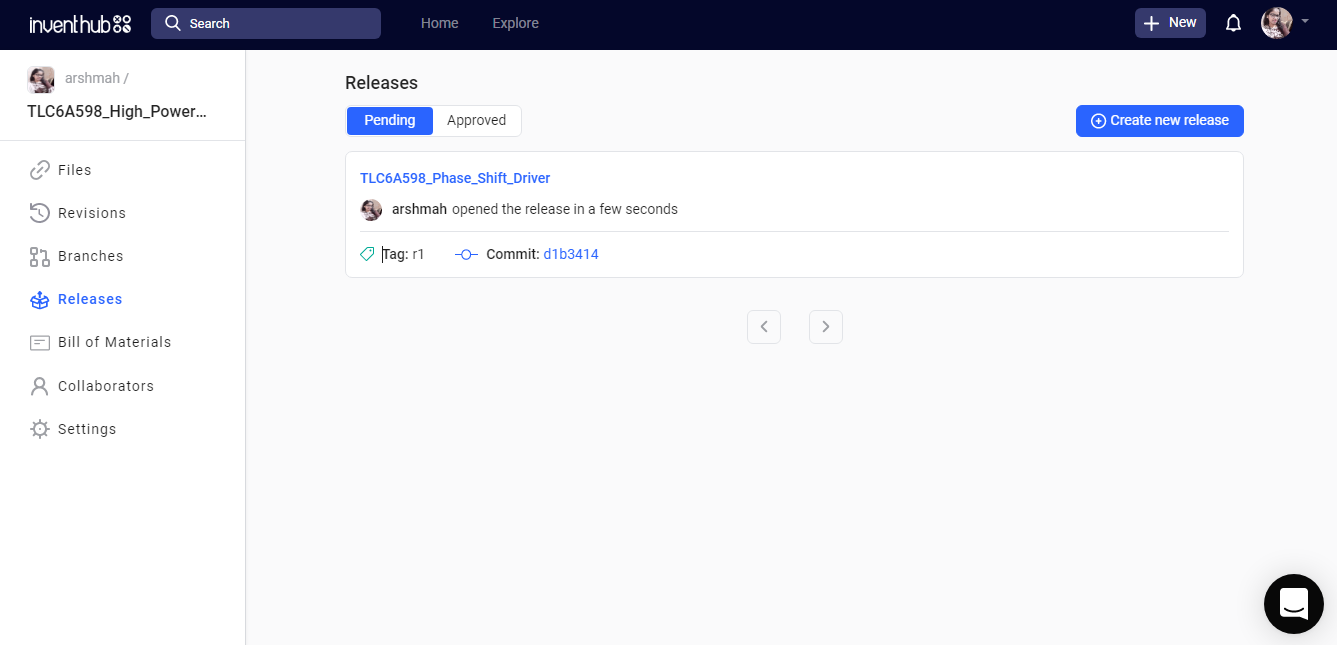
Bill of Materials:
I also have created an online Bill of Material on Inventhub. Sometimes, it becomes difficult to order the component with the same footprint and dimensions as per design requirements. This BOM file contains the details of the dimensions of each component. The component provider can export the file in CSV format and can deliver my components easily. I can calculate the total cost of my project according to the components and manufacturer I have chosen for my design. By clicking on ‘Edit BOM’ I can select the ‘supply chain’ button to calculate the cost of my product.
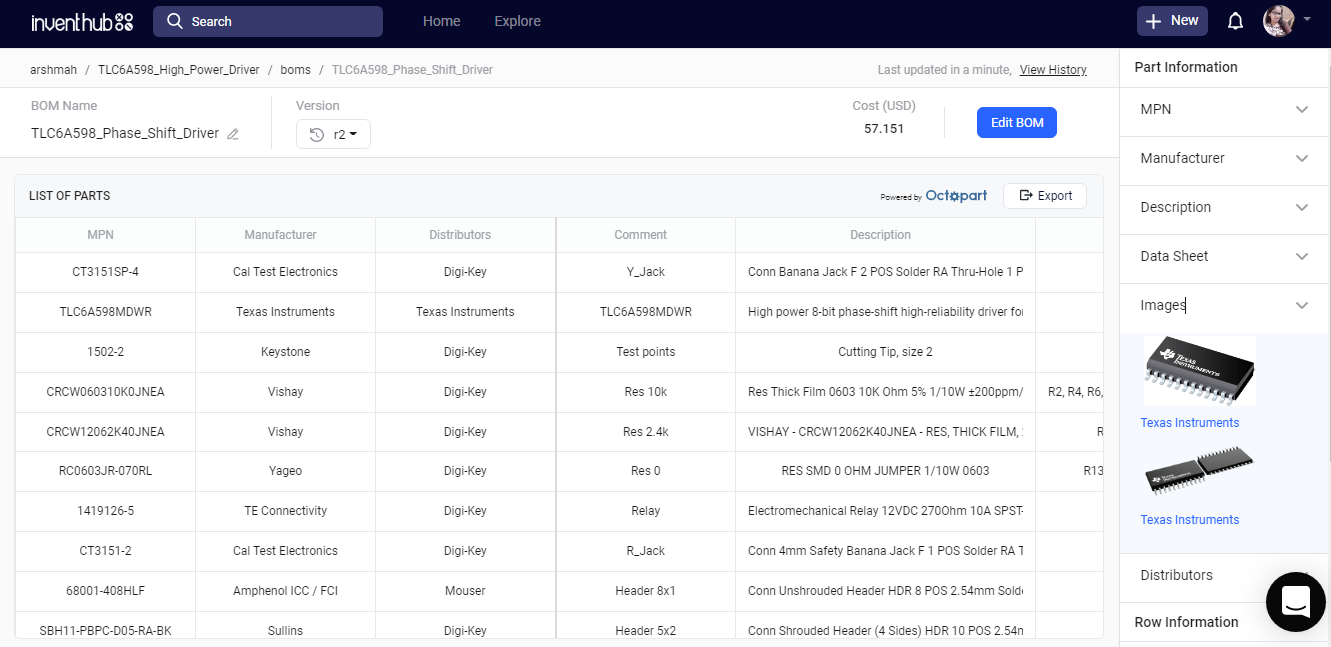
Comparison with other devices:
NPIC6C596:
An existing 8-bit shift register like NPIC6C596 is used in circuits to provide moderate or low power. It has the ability to handle 100mA current which is less compared to the TLC6A598 register. The open-drain outputs are 33 V/100 mA continuous current extended-drain NMOS transistors designed for use in systems that require moderate load power such as LEDs. Integrated voltage clamps in the outputs provide protection against inductive transients making the device suitable for power driver applications such as relays, solenoids, and other low-current or medium-voltage loads.
STPIC6D595:
This STPIC6D595 is a monolithic, medium voltage, low current power 8-bit shift register designed for use in systems that require relatively moderate load power such as LEDs. The device contains an 8-bit serial-in, parallel-out shift register that feeds an 8-bit D-type storage register. Output are low-side, open-drain DMOS transistors with output ratings of 20 V and 120 mA continuous sink-current capability. The STPIC6D595 is characterized for operation over the operating case temperature range of -40 °C to 125 °C.
Why TLC6A598?
As compared to NPIC6C596 and STPIC6D595 devices, TLC6A598 is more efficient and reliable. It protects the loads from any damage. They can work on high power and can limit the current. Following are the major reasons why TLC6A598 is better and preferable to other devices.
- Overcurrent Protection
- Low Power consumption
- Output Detection
- Serial Communication Error detection
- Thermal Shutdown
- Enhanced cascading for multiple stages
- Open and short load detection
Applications:
Due to the high current limiting capacity of TLC6A598, it is used in various applications to protect the load devices like:
- PLC control functions
- Flight control system
- Relay or solenoid drivers
- Display panels and LED indication etc.
The device is designed to drive resistive loads and is particularly well-suited as an interface between a microcontroller and LEDs or lamps. The device also provides up to 2500 V of ESD protection (a device that protects a circuit from an Electrostatic discharge), when tested using the human body model and 750 V when using the machine model. It provides protection against;
- High current
- Short circuit
- Error identification in serial interface communication
- Overheating in devices
Circuit Design and Testing:
The TLC6A598 evaluation board helps designers evaluate the operation and performance of the TLC6A598 8-Bit Shift Register designed for the high current multi-load application.
The TLC6A598 device is designed to operate with an input voltage supply range from 3 V to 5.5 V. It operates with two supply power rails, one power rail for the TLC6A598 and another power rail for the relays. This board is designed to work with the USB2ANY board and USB2ANY Explore Software.
The USB2ANY board is available here.
The test setup of this board by Texas Instruments can be arranged as:
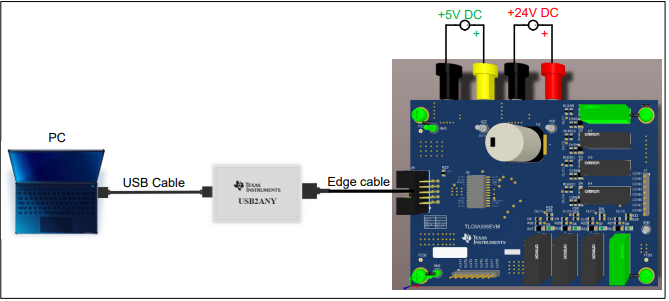
Set the input voltage power supply 1 to 5 V and the current limit to 0.3 A. Turn off the power supply
-
Connect power supply 1 to the J1 and J2 connectors with the positive terminal of the supply connected to VCC (J1) and the negative terminal of the supply connected to GND (J2). Set the input voltage power supply 2 to 24 V and the current limit to 1 A. Turn off the power supply
-
Connect power supply 2 to the J3 and J4 connectors, with the positive terminal of the supply connected to VDD (J3) and the negative terminal of the supply connected to GND (J4). Connect the USB2ANY with Edge cable to J5 and connect USB2ANY to the PC with USB cable. With the above setup and connections completed, turn on the power supply 1 and
-
Then open the USB2ANY Explorer Software. Click the 'Select Interface' button and choose the 'GPIO' and 'SPI' and click the 'Close' button. Click the 'GPIO' button and configure the GPIO3. If you cannot see the 'GPIO' button, please adjust the display scale of the PC to 100%. Click the 'SPI' button and configure the SPI interface. In the 'Write date' command window, write 'FF' and click 'Write/Read' button. Then, the eight relays K1 to K8 will turn on and the eight Green LEDs D1 to D8 will turn on accordingly.
Summary:
The TLC6A598 is better than the existing 8-bit phase shift registers. The existing devices are used to provide low or moderate power to run the devices that are not useful in high power systems, they are not much reliable and inefficient as compared to the TLC6A598. Unlike TLC6A598 they do not provide better protection against different damages at the load side in devices.
 Arshmah Shahkar
Arshmah Shahkar